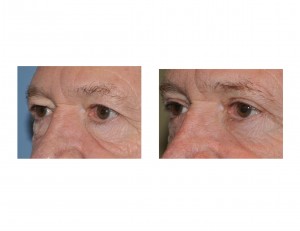Changing the outer corner of the eye is done for a lot of different aesthetic and reconstructive purposes. The two main reasons are to help correct a lower lid sag from prior surgery (reconstructive) or to create more of an uplifted corner of the eye to change its appearance. (aesthetic) The procedures used to do so are either a lateral canthopexy or a lateral canthoplasty
The changes that occur between a canthopexy and canthoplasty is often subtle but how they are performed, their indications and the effects that result from their use is very specifically different. Understanding these eye corner manipulations requires an appreciation of eye shape.
The shape of the eye is really determined by how the upper and lower eyelids join at the corner. This is much more so at the outer corner of the eye than the inner. (at least for Caucasians) A youthful eye is associated with a space between the upper and lower eyelids that is narrow and more drawn out to the side. In some ways it is a tight ‘bowstring’ look provided that the bony anatomy of orbit and cheek is normally developed around it. As one ages the shape of the eye changes as the lower eyelid droops. This creates an eye shape that is now rounder and horizontally shorter. In effect the bowstring effect is weakened.


Conversely, a lateral canthoplasty is more invasive and requires fixing deeper tissues of the lower eyelid (tarsus or muscle) to the inner aspect of the lateral orbital rim. This is usually most effectively done by placing drill holes in the lateral orbital rim where a transosseous suture can be passed to ensure that the new canthal attachment is ‘high and tight’ inside the orbital rim.
While effectively restoring the bowstring effect of the lower eyelid against the eyeball, it does so at the expense of shortening the lower eyelid and giving it a rounder shape. For this reason lateral canthoplasties are primarily used as a reconstructive procedure for significant lower lild retraction. It restores lower lid competence but not necessarily a more youthful looking eye shape.
Dr. Barry Eppley
Indianapolis, Indiana


